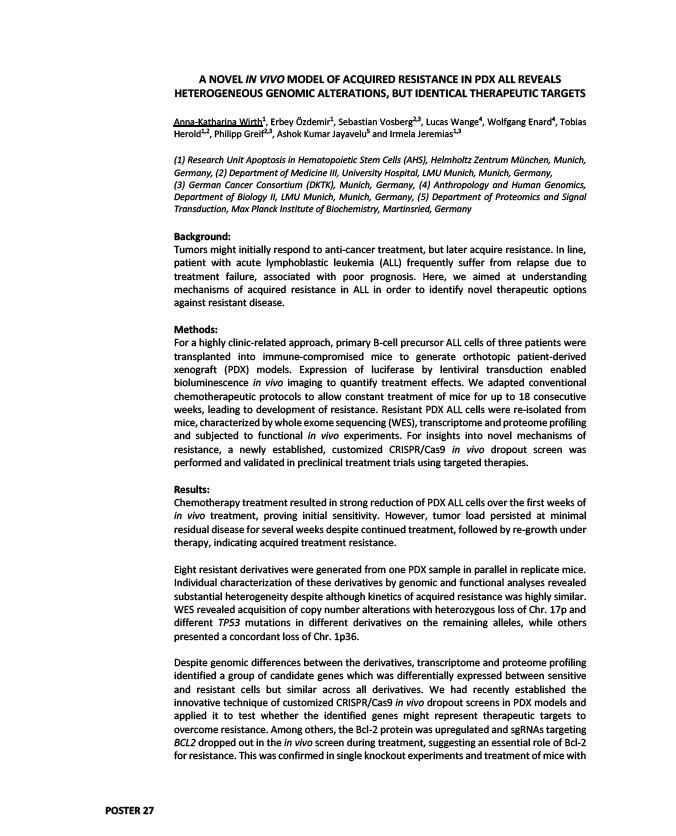
A NOVEL IN VIVO MODEL OF ACQUIRED RESISTANCE IN PDX ALL REVEALS
HETEROGENEOUS GENOMIC ALTERATIONS, BUT IDENTICAL THERAPEUTIC TARGETS
Anna-Katharina Wirth1, Erbey Özdemir1, Sebastian Vosberg2,3, Lucas Wange4, Wolfgang Enard4, Tobias
Herold1,2, Philipp Greif2,3, Ashok Kumar Jayavelu5 and Irmela Jeremias1,3
(1) Research Unit Apoptosis in Hematopoietic Stem Cells (AHS), Helmholtz Zentrum München, Munich,
Germany, (2) Department of Medicine III, University Hospital, LMU Munich, Munich, Germany,
(3) German Cancer Consortium (DKTK), Munich, Germany, (4) Anthropology and Human Genomics,
Department of Biology II, LMU Munich, Munich, Germany, (5) Department of Proteomics and Signal
Transduction, Max Planck Institute of Biochemistry, Martinsried, Germany
Background:
Tumors might initially respond to anti-cancer treatment, but later acquire resistance. In line,
patient with acute lymphoblastic leukemia (ALL) frequently suffer from relapse due to
treatment failure, associated with poor prognosis. Here, we aimed at understanding
mechanisms of acquired resistance in ALL in order to identify novel therapeutic options
against resistant disease.
Methods:
For a highly clinic-related approach, primary B-cell precursor ALL cells of three patients were
transplanted into immune-compromised mice to generate orthotopic patient-derived
xenograft (PDX) models. Expression of luciferase by lentiviral transduction enabled
bioluminescence in vivo imaging to quantify treatment effects. We adapted conventional
chemotherapeutic protocols to allow constant treatment of mice for up to 18 consecutive
weeks, leading to development of resistance. Resistant PDX ALL cells were re-isolated from
mice, characterized by whole exome sequencing (WES), transcriptome and proteome profiling
and subjected to functional in vivo experiments. For insights into novel mechanisms of
resistance, a newly established, customized CRISPR/Cas9 in vivo dropout screen was
performed and validated in preclinical treatment trials using targeted therapies.
Results:
Chemotherapy treatment resulted in strong reduction of PDX ALL cells over the first weeks of
in vivo treatment, proving initial sensitivity. However, tumor load persisted at minimal
residual disease for several weeks despite continued treatment, followed by re-growth under
therapy, indicating acquired treatment resistance.
Eight resistant derivatives were generated from one PDX sample in parallel in replicate mice.
Individual characterization of these derivatives by genomic and functional analyses revealed
substantial heterogeneity despite although kinetics of acquired resistance was highly similar.
WES revealed acquisition of copy number alterations with heterozygous loss of Chr. 17p and
different TP53 mutations in different derivatives on the remaining alleles, while others
presented a concordant loss of Chr. 1p36.
Despite genomic differences between the derivatives, transcriptome and proteome profiling
identified a group of candidate genes which was differentially expressed between sensitive
and resistant cells but similar across all derivatives. We had recently established the
innovative technique of customized CRISPR/Cas9 in vivo dropout screens in PDX models and
applied it to test whether the identified genes might represent therapeutic targets to
overcome resistance. Among others, the Bcl-2 protein was upregulated and sgRNAs targeting
BCL2 dropped out in the in vivo screen during treatment, suggesting an essential role of Bcl-2
for resistance. This was confirmed in single knockout experiments and treatment of mice with
POSTER 27